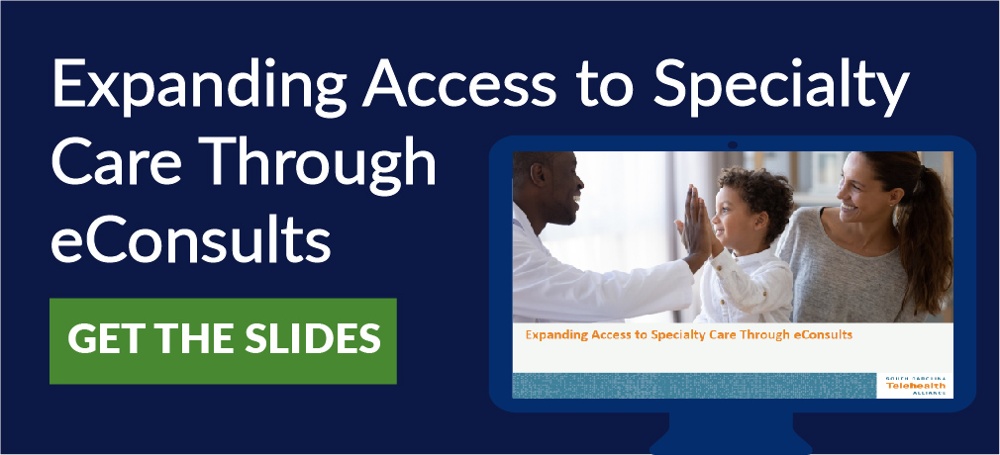Tackling SDoH Barriers to Care With eConsults

I have worked in healthcare administration and digital health IT, including serving as a referral coordinator, for about as long as eConsults have been around; what I’ve seen “in the trenches” provides me with unique insight into the benefits that eConsults can provide.
I’ve worked directly with Federally Qualified Health Centers (FQHCs) and rural health centers across the US, and also trained hundreds of specialists on various eConsult technologies and platforms. I’ve witnessed how eConsults help all types of patients—from those who are low-income and underserved to those who pay for concierge medicine, and the common thread is that eConsults help to democratize medicine.
Provider-to-provider eConsults are a relatively new service in the healthcare landscape, but the concept goes back to the beginning of care, when providers consulted with other providers to make more informed decisions that resulted in better patient outcomes. In the decade since the creation of the “e” version, they have become an invaluable service to the patients who need them most—people with social determinants of health (SDoH) barriers that eConsults are uniquely suited to help them break through.
Let me pause here to clarify how we define eConsults at ReferWell, as the term can be used differently within different healthcare organizations. Generally, an eConsult is a digital interaction between two providers to seek advice on a patient’s care. ReferWell’s eConsults enable asynchronous, online conversations between a requesting and a consulting provider, often a primary care provider (PCP) and a specialist.
There are many use cases. EConsults:
- allow specialists to share their expertise with PCPs in their communities, typically at low or no cost, to support these physicians in making treatment decisions.
- let community health centers expand access and offer broader care for their vulnerable patients.
- avoid unnecessary specialist visits, which lead to increased cost and an inferior patient experience.
- clear space on the specialists’ schedules for patients who require those hard-to-come-by appointments and keeps easily managed patients in primary care.
- strengthen the relationship between primary care providers and specialists so those specialists remain top-of-mind when PCPs need to refer.
Addressing Common SDoH Barriers
Democratizing medicine is key to improving health for all. Patients are often unable to change SDoH factors and their health suffers as a result—but eConsults can help. Even though the patient isn’t part of the eConsult interaction, the patient is the ultimate beneficiary. Because the patient avoids unnecessary doctor visits, eConsults can help bypass the many SDoH barriers that restrict patients from receiving the care that they need.
For example:
- Transportation
- Internet Access
Many patients served by community health centers lack transportation or Internet access; for those who live in rural areas, finding public transportation or Internet can be even harder.
In one case, a client shared with me a story of a patient who walked 19 miles to the nearest library for a video visit with a specialist. There were no specialists practicing near the patient’s home, so the best option was a virtual visit. But the patient had no Internet access at home and the closest location with Internet access was the library. With no car or public transportation, walking was the patient’s best option. An eConsult between the patient’s primary care provider and that specialist could have saved the patient from both transportation and Internet access barriers at the same time.
- Financial/Cost of Care
- Time Off Work
Now, here’s a situation in which eConsults were available and helped the patient surpass SDoH challenges. A client shared with me that a patient would regularly have to miss work for his diabetes management appointments. The patient had limited time off and was heavily dependent on the limited income from his job, so missing work to accommodate these appointments was a bigger burden for him than for some others.
In addition, he was on a fixed income and had trouble affording the expensive diabetes medications his physician had prescribed. The patient had stopped taking his medications to save money.
The physician used an eConsult to seek advice from an endocrinologist at an academic medical center in the state. The specialist recommended a medication change that would be just as effective but less costly for the patient. And, because the PCP and specialist were able to make the adjustment without a separate patient appointment, the patient avoided missing additional time off work.
Telehealth: Not a Substitute for EConsults
At this point, you may be wondering, “What about telehealth visits? Aren’t they just as good as eConsults at overcoming SDoH barriers?”
EConsults offer a few key advantages over telehealth appointments when considering SDoH challenges:
- Because the patient isn’t part of the eConsult interaction, they save the patient time (as telehealth appointments still take some amount of time).
- They also save money on lost wages and the cost of care if an appointment is avoidable.
- They support a closer relationship between the patient and the PCP, since care stays with the primary physician and is informed by the specialists instead of the PCP referring to the specialist.
- Telehealth doesn’t help when the patient lacks Internet access.
EConsults at Academic Medical Centers
In the case above, eConsults were offered by a large, metropolitan, academic medical center as a cost-effective way for primary care and community physicians to consult a specialist they know and trust. EConsults were grant funded, so neither the patient nor the community health center incurred any cost for receiving this guidance, which is also guaranteed to arrive within two business days of the request.
Provider-to-provider eConsults are a win-win-win. They democratize care by bringing the knowledge of the specialist into primary care’s hands, enabling them to provide the best care possible to their patients while addressing the social determinates of health that often keep patients from seeing specialists. At the same time, specialists can share their expertise, optimize scheduling and build relationships with community providers as a low- or no-cost source of advice to improve patient care management.
This article is part one of a four-part series on reducing barriers and improving access to care with eConsults. Part two discusses how to improve eConsult quality.
Written by Meg Wright
Meg specializes in the implementation of eConsult programs, teaching platform users and executing the programs flawlessly. As a client operations manager at ReferWell, Meg brings a decade of experience to ReferWell’s Care Navigation team that is diligently working on assisting in care gap closure programs. On top of her vast eConsult knowledge, Meg is known for the optimism she contributes to her clients and her team.

 © COPYRIGHT REFERWELL
© COPYRIGHT REFERWELL 